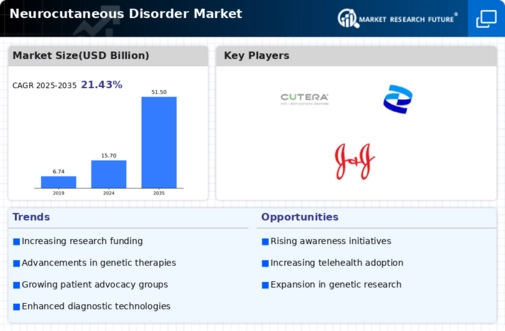Market Trends
Key Emerging Trends in the Neurocutaneous Disorder Market
The escalating prevalence of epilepsy and glaucoma stands out as a pivotal factor propelling the growth of the Sturge-Weber syndrome market. The majority of Sturge-Weber syndrome cases are closely associated with epilepsy and glaucoma. Glaucoma, characterized by elevated eye pressure leading to optic nerve damage, affects approximately 45% of patients grappling with Sturge-Weber syndrome. Consequently, the mounting incidence of glaucoma patients is steering the trajectory of the Sturge-Weber syndrome market. Furthermore, epilepsy, a condition involving a stimulator or pulse generator connected internally, is prevalent in approximately 90% of Sturge-Weber syndrome patients.
Rare diseases, often severe, chronic, and life-threatening, pose a significant healthcare challenge. The World Health Organization reported in 2016 that around 30 million individuals, out of the 508 million population in EU countries, suffer from rare diseases. Many patients with rare diseases still lack confirmed and accurate treatment and diagnosis, underscoring the imperative need for research and development funding to facilitate precise diagnosis and effective treatment.
Presently, a substantial number of market players are actively engaged in research and development endeavors to introduce improved and more effective treatment and diagnostic methods for Sturge-Weber syndrome. Patients grappling with Sturge-Weber syndrome experience various side effects, including seizures, cognitive impairment, developmental delays, and weakness or paralysis on one side of the body. The emphasis on advancing research and development initiatives underscores the commitment to enhancing the quality of life for individuals affected by Sturge-Weber syndrome.
The imperative nature of funding for research and development is accentuated by the fact that rare diseases often lack well-established treatment protocols. In the context of Sturge-Weber syndrome, the associated conditions of epilepsy and glaucoma necessitate nuanced and specialized approaches to diagnosis and treatment. The complexity of these medical conditions requires a concerted effort to unravel the intricacies and develop targeted interventions that can effectively address the specific challenges faced by Sturge-Weber syndrome patients.
As the global healthcare landscape grapples with the multifaceted issues posed by rare diseases, including Sturge-Weber syndrome, the commitment to advancing research and development becomes a linchpin in transforming the outlook for affected individuals. The ongoing efforts to unravel the complexities of Sturge-Weber syndrome, coupled with the quest for innovative treatments and precise diagnostic methodologies, contribute to the broader narrative of progress in rare disease management.
In conclusion, the surge in Sturge-Weber syndrome cases associated with epilepsy and glaucoma underscores the critical need for research and development investments. The challenges posed by rare diseases demand a comprehensive and dedicated approach to unraveling their intricacies and developing targeted interventions. The ongoing endeavors in research and development represent a pivotal step forward in enhancing the understanding, diagnosis, and treatment of Sturge-Weber syndrome, ultimately aiming to improve the quality of life for individuals affected by this rare and complex condition.






Leave a Comment